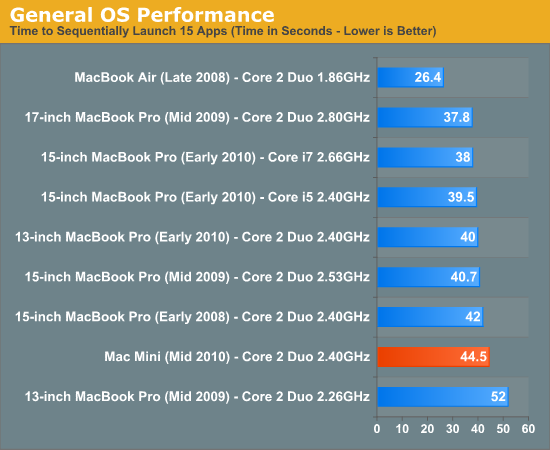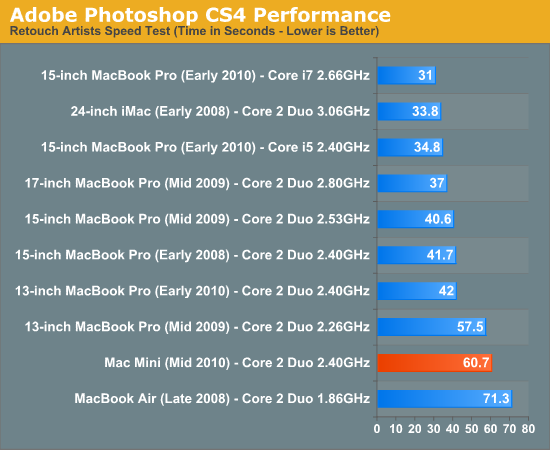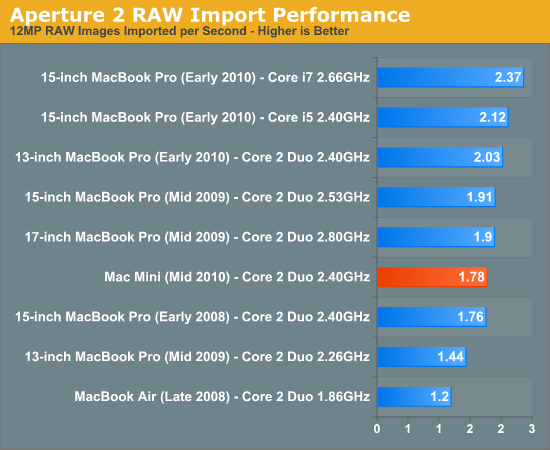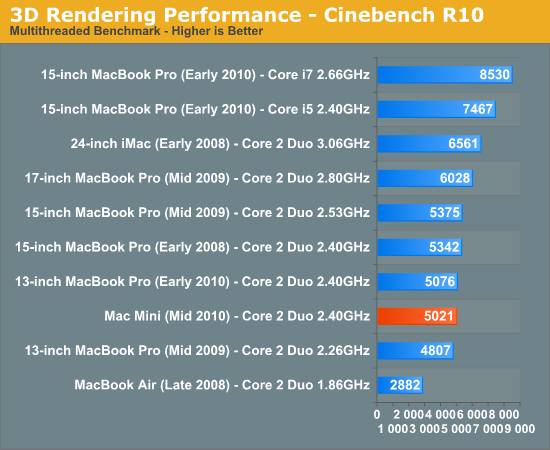Apple Mac mini Review (Mid 2010)
by Anand Lal Shimpi on August 9, 2010 3:37 AM ESTGeneral Performance
The original Mac mini was fast enough for the entry level Mac user back in 2005. Given that Apple’s iPad is fast enough for many users today, I don’t think it’s too difficult to understand that the 2010 Mac mini is sufficient for most needs.
There are two problems with the overall performance of the mini that will contribute to it feeling slow, particularly over time. The first is memory, and I’ll touch on this in more detail later, but 2GB of RAM is simply not sufficient for a computer running a heavyweight OS. Even light multitasking exposes this weakness. The second is the hard drive.
Apple ships the Mac mini with a 2.5” 5400RPM notebook drive. The drive keeps power consumption and noise down to a minimum, while being awful for performance. To Apple’s credit, OS X does a good job of caching frequently used data but without enough RAM this is a wobbly crutch.
The Mac mini is absolutely begging to have an SSD, and unlike the rest of Apple’s Mac lineup, one isn’t even offered on the mini. I’m going to take this opportunity to again plead for Apple to include a decent SSD in its customization options. These days the name of the game is SandForce. While that may change in another quarter or two, we still need Apple to take SSDs more seriously than it has been.
Now on to the numbers. I didn't have any previous generation Intel Mac minis on hand so the performance comparison is mainly to the MacBook/MacBook Pro. I did throw in some results from the early 2008 iMac I reviewed a while back.
General OS Performance
General OS usage is a difficult thing to quantify, but one measure of performance has always been the number of bounces an icon in the dock makes before an application loads. I decided to take it to the next level and write a quick script to launch 15 applications in a row, timing how long the entire process takes.
I launched, in order: Mail, Safari, Activity Monitor, iTunes, iCal, DVD Player, iPhoto, Photo Booth, Quicktime Player, Disk Utility, Preview, iMovie, Front Row, Garage Band and Aperture.
The entire process stresses both the disk and CPU, which is why we see a huge improvement when going to an SSD as well as differences between CPU speeds.

Application launch performance is slower than the 13-inch MacBook Pro because of the mini’s 2GB of memory. You’ll see this trend continuing as we go through our tests.
Adobe Photoshop CS4 Performance
The Retouch Artists Speed Test we use for our CPU testing under Windows also works under OS X. We're running the exact same benchmark here, basically performing a bunch of image manipulations and filters and timing the entire process.

Photoshop performance is decent, but again behind the latest MBPs because we’re swapping to disk. Not only does the mini ship with 2GB of memory but it has to share 256MB with the GeForce 320M.
Aperture 2 RAW Import
For my Aperture test I simply timed how long it took to import 203 12MP RAW images into the library.

Our Aperture test is heavier on the I/O and thus narrows the gap between the 13-inch MBP and the mini.
Cinebench R10
I’m a fan of the Cinebench test because it lets me show off both single and multithreaded performance in the same workload. First, the single threaded performance:


If we’re totally CPU bound, which is the case with Cinebench, you’ll see that the mini performs no differently than the 13-inch MacBook Pro. Compared to a mobile Core i5 you’re looking at roughly 70% of the performance. It’s fast enough, but not speedy.
Quicktime H.264 Video Encoding
Our final benchmark is more consumer focused. Here I'm taking an XviD and converting it to an iPhone-supported H.264 format.

Video encoding performance is once again where we’d expect it to be, roughly on par with the 13-inch MacBook Pro. The new i5 systems are 60% faster.
Maintaining Profit Margins: 2GB vs. 4GB RAM
The $699 mini is the only Mac that currently ships with less than 4GB of memory (except for the MacBook Air). For a $700 system, that’s unacceptable. For a machine that’s sold in 2010, that’s unacceptable. For something that’s not a nettop, well, you get the idea.
The performance gain you see from just adding another 2GB of memory to the 2010 mini is huge. Here’s our Photoshop benchmark before and after an upgrade to 4GB:
| 2010 Mac mini Performance | ||||
| 2GB RAM | 4GB RAM | |||
| Photoshop CS4 Retouch Artists Bench | 60.7 seconds | 42.1 seconds | ||
| Cinebench R11.5 CPU | 1.38 points | 1.39 points | ||
That’s a 44% performance increase! The Cinebench results don't show a similar performance improvement since we're fully CPU bound in an test that easily fits in main memory.
You can argue that not all Mac mini owners won’t be running Photoshop, and I’d even agree with you there, but the memory limits come into play as soon as you start running a couple of large footprint applications. The multitasking falloff is sharp on the Mac mini because you only have 2GB of memory and you’ve got a dirt slow 5400RPM notebook hard drive in there.
The Photoshop results are just to show you something quantifiable. The user experience of the Mac mini is noticeably diminished by only having 2GB of memory.
Upgrading the memory is pretty simple. Just twist the pedestal on the bottom, remove the cover and swap sticks:
Apple ships the mini with 2 x 1GB sticks and the GeForce 320M has a dual-channel DDR3 memory controller so you’ll want to upgrade in pairs as well. Apple charges $100 for the upgrade, which isn’t too bad but you’re better off buying the memory yourself and just eBaying what you get with the system.
You just need to buy DDR3-1066 SO-DIMMs, the same thing you’d put in a notebook.










93 Comments
View All Comments
AssBall - Monday, August 9, 2010 - link
Yeah, that 45 fps at 800x600 in WoW is killer, Dude.wtf
Tros - Monday, August 9, 2010 - link
http://www.anandtech.com/show/2921/419 fps on an overclocked Intel integrated GPU (i3 generation). I'd say going with NVidia's GPU was the better choice by at least two-fold for gaming.
thunng8 - Tuesday, August 10, 2010 - link
Thats right, a standard clocked Intel GPU gets approx 12.5-15fps or less than 1/3rd the performance of the Nvidia 320Mretrospooty - Monday, August 9, 2010 - link
"Apple calls the new Mac mini the world’s most energy-efficient desktop computer"Nice thing to call it, considering its really a laptop with no LCD. Gotta love Job's spin. ROFL
thunng8 - Tuesday, August 10, 2010 - link
Why is it spin if it is correct?jihe - Monday, August 9, 2010 - link
Ridiculously overpriced. Might as well get a laptop and hack off the lcd. Any one care to compare this to a laptop at the same price level?Tros - Monday, August 9, 2010 - link
1) NVidia chipset laptops are hard to find. I imagine this is something like when AMD-powered Dell machines were non-existent.2) Compare it and realize what? Power consumption on the Mac-mini is already lower than it's low-voltage netbook counterpart. Would you compare a T8600 to a T8600?
And yeah, the initial cost is a lot more. But have you considered the cost over time? Even if the ION system was cheaper, the cost-over-time curve has a higher slope because of power consumption and build quality. The Mac-Mini is the better investment for the long-run. Well, unless you replace your HTPC every year, but who has that kind of money?
jihe - Tuesday, August 10, 2010 - link
1) NVidia chipset laptops are everywhere.2) Turn off the screen of your laptop and see how much power it consumes.
The mac mini is half an outdated laptop, for much more than the price of one.
name99 - Tuesday, August 10, 2010 - link
A laptop that runs MacOS X?If you are not in the market for such a machine, fine, but don't pretend you're making deep philosophical points by ignoring this issue.
I don't give a damn about motorbikes. The difference between you and me is that I don't feel a compulsive need to read articles on motorbikes and then offer up my opinion on devices that I have never owned and will never own.
20% or so of the US market feels the overall value of Apple products, from the OS to the generally higher reliability to the much better resale value (or, if you prefer, longer usable lifetime) make them worth buying. If you're not in that group, fine, but is your life really so empty that, rather than going door to door asking people if they have heard the word of god, you feel a need to engage in the equivalent behavior wrt a commercial purchase? "Excuse me, ma'am, but have you heard the words of Bill Gates, and how they can save your dollars and the dollars of your loved ones?"
ManjyomeThunder - Wednesday, August 11, 2010 - link
20%? I hope you're talking about iPhones and not Macintoshes, Considering OS X (all versions) hold around a total of MAYBE 10% of the US market.